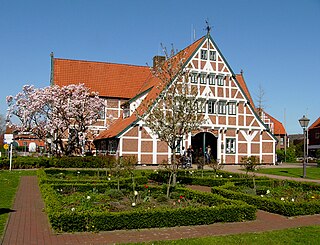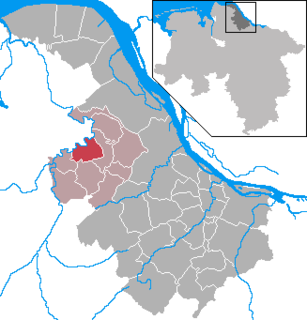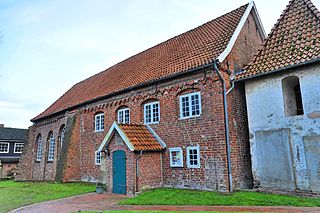
Count Gustaf Adolf Levenhaupt was a Swedish soldier and statesman.

The Archbishopric of Bremen, or Prince-Archbishopric of Bremen — not to be confused with the former Archdiocese of Bremen, and the modern Archdiocese of Hamburg, founded in 1994 — was an ecclesiastical principality (787–1566/1648) of the Holy Roman Empire, which after its definitive secularization in 1648, became the hereditary Duchy of Bremen. The prince-archbishopric, which was under the secular rule of the archbishop, consisted of about a third of the diocesan territory. The city of Bremen was de facto and de jure not part of the prince-archbishopric. Most of the prince-archbishopric lay rather in the area to the north of the city of Bremen, between the Weser and Elbe rivers. Even more confusingly, parts of the prince-archbishopric belonged in religious respect to the neighbouring diocese of Verden, making up 10% of its diocesan territory.

Stade, officially the Hanseatic City of Stade is a city in Lower Saxony in northern Germany. First mentioned in records in 934, it is the seat of the district (Landkreis) which bears its name. It is located roughly 45km to the west of Hamburg and belongs to that city's wider metropolitan region. Within the area of the city are the urban districts of Bützfleth, Hagen, Haddorf and Wiepenkathen, each of which have a council ("Ortsrat") of their own with some autonomous decision-making rights.

Bremen-Verden, formally the Duchies of Bremen and Verden, were two territories and immediate fiefs of the Holy Roman Empire, which emerged and gained imperial immediacy in 1180. By their original constitution they were prince-bishoprics of the Archdiocese of Bremen and Bishopric of Verden.

Jork is a small town on the left bank of the Elbe, near Hamburg (Germany).

Land Wursten is a former Samtgemeinde in the district of Cuxhaven, in Lower Saxony, Germany. It was situated approximately 20 km (12 mi) southwest of Cuxhaven, and 15 km (9.3 mi) north of Bremerhaven. Its seat was in the village Dorum. It was disbanded in January 2015, when its member municipalities merged into the new municipality Wurster Nordseeküste.

Mittelstenahe is a municipality in the district of Cuxhaven, in Lower Saxony, Germany.

Burweg is a municipality in the district of Stade, Lower Saxony, Germany.

Düdenbüttel is a municipality in the district of Stade, Lower Saxony, Germany.

Engelschoff is a municipality in the district of Stade, Lower Saxony, Germany.

Großenwörden is a municipality in the district of Stade, Lower Saxony, Germany.

Wischhafen is a municipality in the district of Stade, in Lower Saxony, Germany.

Rübke (help·info) a village located in the north of Lower Saxony, Germany. Its population is approximately 500 and consists of two main roads.

The region between the Elbe and Weser rivers forms the Elbe–Weser triangle, also rendered Elbe-Weser Triangle, in northern Germany. It is also colloquially referred to as the Nasses Dreieck or "wet triangle".

The Westerberg in Rahden is a low ridge in Northern Germany in the north of the collective municipality of Börde Lamstedt in the state of Lower Saxony. It is covered with mixed forest and, like the nearby Wingst ridge, it is an end moraine from the Saale glaciation period. Together with the Wingst it forms part of the eastern boundary of Land Hadeln.

The Saint Mary's Church is a Lutheran parish church used and owned by the Lutheran parish in Himmelpforten, Lower Saxony, Germany. The Himmelpforten parish forms part of the Stade deanery (Kirchenkreis) within the Stade diocese of the Lutheran Church of Hanover. The church was completed in 1738 and covers the eastern half of the foundations of the demolished abbey church of the former Himmelpforten Convent.

The Neuenwalde Convent is a Lutheran damsels' convent in Neuenwalde, a locality of Geestland, Lower Saxony, Germany.

The Holy Cross Church is the church of the Neuenwalde Convent. Convent and Holy Cross Church are owned by the Bremian Knighthood, based in Stade. However, church and parsonage, are used per usufruct by the Lutheran Neuenwalde Congregation in Neuenwalde, a locality of Geestland, Lower Saxony, Germany. Besides the Holy Cross Church, only used, the congregation uses and owns the chapel in Hymendorf.






























